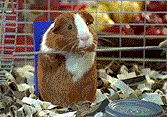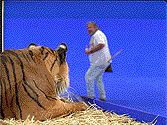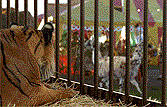lthough the majority of the shots featuring Rodney the guinea pig (voiced by Chris Rock) were achieved through the combined talents of Jim Henson's Creature Shop animatronics and Pacific Ocean Post's

The guinea pig was photographed against a blue board (to keep him from falling), with his paws attached to a metal rod, all of which had to be meticulously erased before animation could begin.
 Rodney doin' his thing, in one of our guinea pig shots.
Rodney doin' his thing, in one of our guinea pig shots.
©1998 Twentieth Century Fox
|
Inferno team, BFTR was asked to tackle one of the most challenging and arguably the funniest Rodney scene in the film: the little rodent singing and dancing to both "Get Down Tonight" and "Lady Marmalade" in his cage.
For this brief scene, comprised of three shots (a wide shot and two closeups), the live animal was "puppeted" in its cage environment by placing its front paws on a metal rod, which was swung back and forth by its trainer, thus creating a basic "butter churn" dance move. Rodney and the back half of the cage were shot against bluescreen, with the foreground cage bars, clean cage and a clean location background plate shot separately.
Before any character animation could begin, the puppeteered rod --which moved across the front of the animal, obscuring its paws, ruffling its fur and casting a shadow-- had to be erased from the image. The fact that live guinea pigs are basically quivering sacks of loose fur made the roto and paint work all the more meticulous. In addition, a small wooden block painted blue was placed just behind the lower half of the standing guinea pig to prop him up, since the rod motion kept making him fall over! The frame-by-frame paintout of all of these artifacts was done by Erich Ippen and Van using Puffin Design's Commotion for the Mac, which allowed us to check the continuity of the fur in motion.
To avoid the look of Rodney's paws resting on and moving with a now-invisible rod, Erich modeled and animated a pair of guinea pig paws in Softimage; this made it possible for him not only to animate little guinea pig fingers pointing to the beat, but also to move the hands around in relation to each other, thereby taking the curse off the influence of the rod.
The facial animation and lip sync, which included blinking and squinting eyes and a mouth containing Chris Rock-like buck teeth supplied by POP, was done using Adobe After Effects. In addition to the face and whiskers, Rodney was also isolated from the background entirely by Erich and artist Todd Vaziri to allow Rodney to rock his head back and forth, a motion that didn't exist in the original footage. The animated elements were then composited by Van for the final shots; the wide shot was used extensively in the trailers and TV commercials for the film.


One of our complex effects shots from DR. DOLITTLE. At top are some of the elements that made up the final composite (below).
©1998 Twentieth Century Fox
|
And contrary to the laments of some reviewers (who obviously weren't paying attention), there WAS a 'pushmi-pullyu' in the film; this holdover/homage to the the Rex Harrison film --and the original Hugh Lofting books-- can be seen walking through the midground in one brief shot when Dolittle converses with Jake in his cage at the circus. To create the fanciful quadruped with a head at each end of its body, the production shot footage of a spotted llama named Dolly (who was naturally referred to as the "Dolly llama") walking back and forth in front of a bluescreen. The animal was to cross right-to-left in the final shot, so the take of Dolly walking left-to-right was run backwards and splitscreened with the right-to-left walking take; the seam between the two halves was digitally blended and the resultant image was composited into the live action circus background.
With the sole exception of the 3D hands Erich made for Rodney in Softimage, Macintoshes were used exclusively to create and composite the shots, although several Intergraph NT systems running After Effects were used as additional rendering engines as the delivery deadline approached.
Every one of the nearly 50 BFTR shots for DR. DOLITTLE was animated and composited in Adobe After Effects, with extensive use of MetaCreations' Final Effects Complete, along with a smattering of DigiEffects' Berserk and ISFX's Matte Wizard plug-ins. Our viewing tools included Commotion on the Mac and Nothing Real's Shake on the SGI.
All in all, our shots held their own alongside those of our fellow houses, which included Vision Art, Pacific Ocean Post, Cinesite and C.O.R.E. Digital; the best compliment we received, however, was from DOLITTLE director Betty Thomas, who said "Those folks at BFTR really know how to act." continued...
